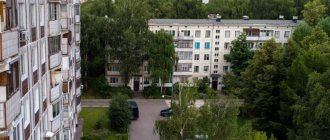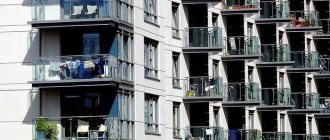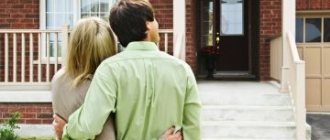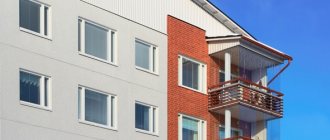What is included in the total area of an apartment in 2020
- determining the amount of payment for central heating;
- calculation of the apartment owner’s share in the common property of an apartment building;
- determination of the tax base in case of payment of land tax on a plot that is in common shared ownership (in proportion to the total square footage);
- determining the base for calculating housing tax and tax deduction for citizens;
- calculating the price per square meter of total square footage in the case of transferring housing to people when
- their residential building being in disrepair and the implementation of citizen resettlement programs;
- calculation of the accounting standard for living space;
- calculating the area of an apartment, which is transferred to citizens on the basis of a social tenancy agreement or into the ownership of certain categories of citizens (disabled people, orphans, military personnel);
- determining the amount of gratuitous social payments for apartments, which are made from the federal budget.
General points
Dear readers! The article talks about typical ways to resolve legal issues, but each case is individual. If you want to find out how to solve your particular problem , contact a consultant:
Point 2.2. The total area of an apartment is the sum of the areas of its heated rooms and premises, built-in closets, as well as unheated rooms, calculated with reduction factors established by the rules of technical inventory.
Is the balcony included in the total area of the apartment?
The same is said in the mandatory Appendix No. 2 to SNiP 2.08.01-89. Paragraph 2 of the Appendix states “The total area of apartments should be determined as the sum of the areas of their premises, built-in wardrobes, as well as loggias, balconies, verandas, terraces and cold storage rooms, calculated with the following reduction factors: for loggias - 0.5, for balconies and terraces - 0.3, for verandas and cold storage rooms - 1.0.”
This is interesting: Contributions to the Moscow Bar Association 2020
Should the area of a balcony or loggia be taken into account when the developer evaluates the cost of an apartment?
The answer is, it should. After all, the developer spends building materials, effort and time on its production, and any work, as we know, must be paid for. This is exactly what is stated in SNiPs and SPs, as well as in the letter of the Ministry of Regional Development of the Russian Federation dated October 9, 2009 N 33350-IP/08.
❓ Is the loggia included in the total area of the apartment.
Loggias, balconies, and terraces belong to common areas of the house and are not considered residential. They are taken into account with a reduction factor. We will tell you more about the coefficient further.
How is the living area of an apartment calculated?
Before you begin the calculations, you need to understand in detail what is included in the general square footage of the apartment and what is included in the residential area.
Thanks to this, you can avoid many inaccuracies and errors when determining the area. After all, errors in technical documentation for housing are unacceptable.
Let's consider the formula for calculating living space, whether the balcony and loggia are taken into account, whether the loggia is included in the total area of the apartment, as well as how to carry out the calculation legally correctly.
Formula applied
Significant difficulties may arise when calculating the general and residential quadrature. The main questions that we will clarify for you in advance are:
- how to correctly and legally calculate the square footage of a room - total, with partitions, balconies and loggias, extensions and terraces;
- nuances for a studio apartment.
In most cases, it is necessary to calculate the total quadrature, which is quite simple to do.
Based on the Housing Code of the Russian Federation, the total area includes the territories of subsidiary territories required to ensure the sanitary and domestic needs of persons living in the apartment.
Video: Russia's largest communal apartment
Exceptions in this case are balconies, verandas and terraces. The category of utility rooms includes corridors, bathrooms and toilet rooms, storage rooms, and built-in wardrobes.
It is necessary to delimit the total area and quadrature, which includes balconies and loggias, terraces and verandas.
The following coefficients are used for these territories:
| For balconies and terraces | 0,3% |
| For loggias | 0,5% |
| For verandas and cold storage rooms | 1% |
To determine the exact total area, it is necessary to add the area of all territories within one apartment.
In 2020, in accordance with legislative acts, the total quadrature includes:
- toilet;
- bathroom;
- corridor;
- kitchen area;
- pantry or closet;
- auxiliary premises for various purposes (except for balconies, verandas, loggias and terraces).
Is a balcony (loggia) considered?
Let's figure out whether the balcony is included in the total area of the apartment. Sometimes situations occur when greedy officials or government employees attempt to add a balcony or loggia to the general square footage of an apartment.
However, such an action is considered a violation of the provisions of Law No. 384-FZ of December 30, 2009.
In this case, officials refer to previous regulatory documents that have actually lost their legal force.
Citizens have the right to indicate to them that the above Federal Law repeals and corrects the effect of previous legislation.
Previously, before the adoption of the Federal Law, balconies and loggias were necessarily included in the overall square footage of the apartment during the preparation of technical documentation for the apartment, in particular the technical passport.
Find out how to apply for a subsidy for utility bills in 2020 from the article: how to get a subsidy for utility bills. How to convert residential premises into non-residential premises, read here.
The procedure for privatizing a dacha in 2020 can be found here.
In 2020, it is prohibited to add loggias and balconies to the total area. Otherwise, this will be considered a gross violation, which will entail the need for a recalculation.
Total area of the apartment - what is it?
The right of private property extends only to what is within these limits. In such a case, it is unlawful to demand payment for extra unheated meters. Naturally, there will be no complaints regarding the use of this space. But remember that you should not damage or interfere with public property, so as not to receive a fine.
What is the total square footage of housing
Study the BTI conclusions.
After the house is built, the state commission accepts the finished object. In order to deliver the property, the developer must know the exact number of square meters of construction. Local BTI specialists help with calculations and record them in documents with summary data tables. The data is divided into categories, including unheated rooms. Then BTI employees issue certificates for individual apartments with the mandatory application of a reduction factor.
Thanks for the answer ! But the logic of such a decision by legislators is incomprehensible! What is it - now it turns out that when selling an apartment there is no loggia!? And it doesn’t matter that it is decorated almost like a living space. The only difference is that it’s cold in winter!
The total area of a residential premises consists of the sum of the area of all parts of such premises, including the area of auxiliary premises intended to satisfy citizens' household and other needs related to their residence in residential premises, with the exception of balconies, loggias, verandas and terraces.
Verified by CIAN
Or is this generally of little significance for the purchase and sale of secondary housing? - not “little significant”, but not significant at all. from the point of view of pricing, only the very fact of the presence/absence of a balcony or loggia is of some importance. if you have drawn in your mind some price per square meter and are now thinking whether to add to it the area of the loggia with a coefficient of 0.7, as it was calculated before, or not, then this is complete nonsense: the market itself will regulate these illusions))
This is interesting: List of benefits for labor veterans in Belgorod in 2020
When changes occurred in the calculation of square meters, the question became - what to pay for? In this case, is the loggia included in the area for which you will pay a fee? Yes, you will. But, in different columns. When calculating the rent, you pay for all square meters, including non-residential and unheated (in our case, the loggia). But, when paying for heating, only those rooms that are common (kitchen, toilet, corridor) are paid. And, if you find that you are being charged for heating, including for the loggia, you have the right to demand compensation for damage.
Commentary to Art. 15 Residential Complex of the Russian Federation
1. Residential is understood as an isolated premises, which is real estate and is suitable for permanent residence (meets established sanitary and technical rules and regulations, and other legal requirements). It follows from this that residential premises are intended for the residence of citizens. They can be in state ownership (Article 214 of the Civil Code of the Russian Federation), municipal property (Article 215 of the Civil Code of the Russian Federation), in the ownership of citizens and legal entities (Article 213 of the Civil Code of the Russian Federation), which is reflected in Part 2 of Art. 19 Housing Code of the Russian Federation.
Let's consider the characteristics of the object of housing rights.
Firstly, this is an isolated room.
However, let us turn to Art. 76 of the Housing Code of the Russian Federation, according to which the tenant of a residential premises under a social tenancy agreement has the right to sublease part of the residential premises, i.e. and part of the room.
Thus, the object of housing rights can be not only an isolated premises; whereas the subject (object) of a housing rental agreement can only be an isolated residential premises (Article 62 of the Housing Code of the Russian Federation, Article 673 of the Civil Code of the Russian Federation).
Secondly, this is a living space. A necessary characteristic of housing is its purpose for the residence of citizens. This position is contained in Art. 17 Housing Code of the Russian Federation (Part 1). Only a room that is functionally intended for living is considered residential. Article 288 of the Civil Code of the Russian Federation (clause 2) establishes: “Residential premises are intended for the residence of citizens.”
Hotels, sanatoriums, holiday homes, boarding houses, etc. have a different functional purpose, i.e. are a place of rest and treatment. Such premises are used for temporary stay, as opposed to a place of residence. Place of residence according to Art. 20 of the Civil Code of the Russian Federation recognizes the place where a citizen permanently or primarily resides.
Thirdly, this is a premises suitable for permanent residence. This means that in terms of area, layout, illumination, insolation, microclimate, air exchange, levels of noise, vibration, ionizing and other radiation, it must comply with sanitary rules in order to ensure safe and harmless living conditions (Article 23 of the Federal Law of March 30, 1999 N 52-FZ “On the sanitary and epidemiological welfare of the population”). In addition to sanitary rules, residential premises must comply with technical rules and regulations, other legal requirements: stationary structure, the presence of certain types of amenities, auxiliary premises, etc.
2. The commented article does not mention such a requirement as landscaping. However, what is important for a person is the comfort of living, the sum of the consumer qualities of housing. An essential part of comfort is landscaping. It follows that a residential premises must meet not only sanitary and technical requirements, but also a certain degree of improvement in order for it to be the object of housing rights.
Requirements to provide residential premises with certain types of “improvement” are contained in the Regulations on the recognition of premises as residential premises, residential premises unsuitable for habitation and an apartment building as unsafe and subject to demolition, approved. Decree of the Government of the Russian Federation dated January 28, 2006 N 47.
The degree of improvement in cities and other settlements varies. In this regard, the wording of Art. 40 of the Housing Code of the RSFSR (“Requirements for residential premises”): residential premises provided for citizens to live in must be well-equipped “in relation to the conditions of a given locality.”
3. The procedure for recognizing a premises as residential and the requirements that it must meet are established by the Government of the Russian Federation (Part 3 of the commented article). The grounds and procedure for recognizing residential premises as unfit for habitation are also established by the Government of the Russian Federation (Part 4 of the commented article).
The Government of the Russian Federation adopted Resolution No. 47 of January 28, 2006, which approved the Regulations on recognizing premises as residential premises, residential premises unsuitable for habitation and an apartment building as unsafe and subject to demolition or reconstruction.
According to this Regulation, residential buildings and residential premises are considered unsuitable for living: having a certain physical wear and tear; in disrepair; in which the harmful effects of environmental factors have been identified (Section III of the Regulations).
Thus, unsuitability is determined by the degree of deterioration of housing (the extreme degree is the accident rate), namely: the presence of irreparable faults in utility networks, non-compliance with building codes when developing the territory close to the house, etc.
The criteria for classifying housing as unsuitable due to the harmful effects of environmental factors are provided for by state sanitary and epidemiological rules and regulations.
Issues regarding the recognition of residential buildings (residential premises) as unfit for habitation are resolved by interdepartmental commissions.
The federal executive body creates, in accordance with the procedure established by it, a commission to evaluate residential premises of the housing stock of the Russian Federation. The commission includes representatives of this federal executive body. An official of the specified federal executive body is appointed as the chairman of the commission.
In the same way, they create their own commissions: the executive body of the constituent entity of the Russian Federation - to assess the residential premises of the regional housing stock; local government body - to assess the residential premises of the municipal housing stock.
The owner of the housing stock or a representative of the owner performing the functions of managing the housing stock, in relation to the residential building (residential premises) of which the issue of declaring it unfit for habitation, and, if necessary, a representative of design and survey organizations, should be involved in the work of the commission, who carried out the inspection of this residential building (residential premises).
The commission, based on an application from the owner of the premises or an application from a citizen (tenant) or on the conclusion of state control and supervision bodies, assesses the compliance of the premises with the requirements established in the Regulations.
After studying the submitted documents, the list of which is provided for in clause 45 of the Regulations, and, if necessary, inspecting the residential building (residential premises), the commission makes a decision:
on the suitability of a residential building (residential premises) for living;
on the need and possibility of carrying out major repairs, reconstruction or redevelopment (if necessary, with a feasibility study) in order to bring the characteristics of the residential premises lost during operation into compliance with the requirements established in the Regulations and after their completion - on the continuation of the assessment procedure;
This is important to know: Developer’s guarantee for an apartment building: current standard
on the unsuitability of a residential building (residential premises) for habitation, indicating defects that cannot be eliminated technically or the elimination of which is not economically feasible, and the criteria for unsuitability;
on recognizing an apartment building as unsafe and subject to demolition or reconstruction (clause 47).
The decision of the commission can be appealed by interested parties in court.
If a residential building (residential premises) is declared unfit for habitation due to an emergency condition or the harmful effects of environmental factors that pose a particular danger to the life and health of people, the decision must indicate to the owner (a person authorized by the owner) the need to immediately resettle citizens.
4. In accordance with Part 5 of the commented article, the total area of a residential premises consists of the sum of the areas of all parts of such premises, including the area of auxiliary premises intended to satisfy citizens’ household and other needs related to their residence in residential premises, with the exception of balconies, loggias, verandas, terraces.
Is the area of the loggia and balcony included in the total area of the apartment?
The SNiP of 2003 also clearly states that the minimum sizes of apartments are calculated by the area of rooms and their number, also without taking into account the area of balconies, loggias, verandas, terraces, apartment vestibules and unheated storage rooms.
Is a balcony or loggia included in the total area of the apartment?
Does the balcony count towards the total area of the apartment? This is a relevant question for many. Particularly interested in individuals buying square meters in new apartment buildings. Sales departments use a trick, selling a home with a smaller area than originally stated.
Recently, owners of apartments located on the top floors have often practiced redevelopment. As a result of such individual construction manipulations, the loggia becomes part of the heated zone of the room. Then it is definitely included in the total area of the apartment.
Is the balcony area included in the total area of the apartment 2020
Often, apartment owners are faced with the question: are they the direct owners of their own loggias and balconies, is the area of the balcony included in the area of the apartment? For most people, a loggia is a free place where you can store old things: children's sleighs, skis, empty cans and notebooks with notes from their studies. But, returning to your home one day, you suddenly noticed that your loggia is used not only from the inside, but also from the street side.
Let's figure out whether the loggia is included in the total area of the apartment
An apartment is a room in an apartment building that is structurally separate and provides direct access to common areas in such a building. The apartment consists of one or more rooms, as well as additional premises, which ensure the satisfaction of citizens with household and other necessities that ensure their residence (prosperous existence) in such a strictly designated room.
This is interesting: Online UTII tax calculator 2020
Also, the question of owning a loggia may arise when you notice that the fee for the heated area of the premises has increased. Not dramatically, but the changes are noticeable. The housing office may tell you that as the owner of the apartment, you pay for its entire area, including unheated space.
A huge number of unscrupulous construction companies, when attracting a client base, often confuse future owners with their terminology, which leads to an unreasonable overpayment due to incorrect calculation of the housing area. In this regard, you should clearly understand the calculation procedures and be extremely careful when determining the cost of 1 square meter of living space.
Is the loggia part of the apartment? Balconies and loggias
Based on paragraph 3.37 of the Instructions, it is determined by the sum of the areas of all premises, including a balcony, terrace, loggia, veranda and cold storage rooms. The latter are calculated using reduction coefficients: for balconies and terraces the coefficient is 0.3, for loggias - 0.5, and for verandas and storage rooms - 1.
To carry out reconstruction, the homeowner must develop a project. The service of a specialized organization will help with this, with the conclusion of an agreement. Author's and technical supervision of the construction process is provided.
Commentary to Art. 15 Residential Complex of the Russian Federation
1. In accordance with the most common point of view, the object of the legal relationship is what this legal relationship is about. Housing legal relations arise regarding residential premises. Therefore, Part 1 of the commented article states that the objects of housing rights are residential premises.
2. An isolated premises intended for the residence of citizens is considered residential. Traditionally, isolated premises are those that have autonomous access to common areas (corridor, hallway, landing, etc.) or to the street (see also commentary to Article 16 of the Housing Code).
3. At first glance, the indication that a residential premises is recognized as an isolated premises, which is real estate, is devoid of legal content. Moreover, by virtue of Art. 1 of the Federal Law of July 21, 1997 N 122-FZ “On state registration of rights to real estate and transactions with it” (hereinafter referred to as the Law on Registration of Rights), residential premises are classified as real estate. However, this instruction makes sense. ——————————— NW RF. 1997. N 30. Art. 3594.
Unfortunately, a considerable number of citizens still live in prefabricated houses, trailers, beams, etc. Such objects are not real estate (there is no strong connection with the land). Relations regarding their use for living are not regulated by housing legislation (in appropriate cases, the norms of civil law on property lease (lease) agreements are applied). This is precisely what is emphasized by the indication that the living quarters, i.e. a thing that is the object of housing rights is recognized as a premises related to real estate.
4. Only those premises that are suitable for permanent residence of citizens are considered residential. Here (in Part 2 of the commented article) it is explained in which cases an apartment, house and other premises are considered suitable for permanent residence - they must meet established sanitary and technical rules and regulations, and other legal requirements. To resolve the issue of compliance of a particular premises with these requirements, materials from the technical inventory bureau, sanitary and epidemiological services, conclusions of technical (and other) examinations, etc. are used.
5. The procedure for recognizing premises as residential and the requirements that residential premises must meet are established by the Government of the Russian Federation, which, by Resolution No. 47 of January 28, 2006, approved the Regulations on recognizing premises as residential premises, residential premises unsuitable for habitation and an apartment building as unsafe and subject to demolition or reconstruction.
The effect of this Regulation applies to residential premises in operation located on the territory of Russia (clause 2), regardless of the form of ownership and does not apply to residential premises located in capital construction projects, the commissioning of which and registration with the state have not been carried out in in accordance with the Town Planning Code of the Russian Federation (clause 3).
6. The recognition of a premises as residential, suitable (unsuitable) for citizens to live in, as well as an apartment building as unsafe and subject to demolition or reconstruction is carried out by an interdepartmental commission created for these purposes.
Depending on the type of housing stock by form of ownership, the interdepartmental commission is created, respectively, by the federal executive body, the executive body of the subject of the Federation, or the local government body. The commission includes representatives of the body that decided to create it, as well as representatives of bodies authorized to carry out state control and supervision in the areas of sanitary-epidemiological, fire, industrial, environmental and other safety, consumer rights protection and human well-being, to carry out inventory and rehabilitation of real estate objects. Where necessary, representatives of architecture, urban planning and other relevant organizations are also involved.
The owner of the residential premises (the person authorized by him) is involved in the work of the commission with the right of an advisory vote, and, in necessary cases, experts from design and survey organizations with the right of a casting vote.
A representative of the body that made the decision to create it is appointed as the chairman of the commission (clause 7 of the said Regulations).
A local government body has the right to make a decision on recognizing private residential premises located on the relevant territory as suitable (unsuitable) for citizens to live in and delegate to an interdepartmental commission the authority to assess the compliance of these premises with established requirements and to make a decision on recognizing these premises as suitable (unsuitable) for living. citizens (clause 8 of the Regulations). ——————————— The given instructions on the powers of the interdepartmental commission contained in the Regulations under consideration appear to be contrary to the law. Thus, the recognition of residential premises of the housing stock of a subject of the Federation as unsuitable for habitation is the responsibility of the state authorities of the subject of the Federation (Clause 6, Article 13 of the Housing Code). The recognition of residential premises of the municipal housing stock as unsuitable for habitation must be carried out by local government bodies (clause 8, part 1, article 14 of the Housing Code). It is clear that the interdepartmental commission cannot be considered either a state authority or a local government body (strangely, the Resolution of the Plenum of the Armed Forces of the Russian Federation dated July 2, 2009 refers to this commission as a body (clause 22)).
7. The said Regulations define in sufficient detail for an act of this level the requirements that a residential premises must meet. In particular, requirements are formulated for the load-bearing and enclosing structures of residential premises (clause 10), the arrangement and equipment of residential premises and the common property of premises owners in an apartment building (primarily in order to prevent the risk of injury, ensure the convenience and safety of movement and accommodation (clause 11)), engineering systems (clauses 12 - 14), etc. The regulation stipulates that residential premises, as well as premises that are part of the common property of premises owners in an apartment building, must be protected from the penetration of rain, melt and ground water and possible domestic water leaks from engineering systems (clause 16); access to residential premises located in an apartment building above the fifth floor, with the exception of the attic floor, must be provided using an elevator (clause 17); placement of residential premises in the basement and ground floors is not allowed (clause 23); placement of a toilet, bathroom (shower) and kitchen above the rooms is not allowed (equipment of a toilet, bathroom (shower) on the upper level above the kitchen is possible in apartments located on two levels (clause 24), etc.
This is important to know: How to divide non-residential premises into two separate ones
The Regulations also contain requirements for space-planning solutions for residential premises (clause 20), insolation (clause 21), height of premises (clause 22), electric field strength, magnetic field induction (clause 30), etc. At the same time Regulatory and technical instructions are often formulated. Thus, in a living room at a distance of 0.2 m from walls and windows and at a height of 0.5 - 1.8 m from the floor, the electric field strength of an industrial frequency of 50 Hz and the magnetic field induction of an industrial frequency of 50 Hz should not exceed 0.5, respectively kV/m and 10 µT (item 30); inside a residential premises, the equivalent radiation dose rate should not exceed the dose rate permissible for an open area by more than 0.3 μSv/h, and the average annual volumetric activity of radon in the air of operated premises should not exceed 200 Bq/cubic meter. m (clause 31).
Naturally, reference standards are also used to determine the requirements that residential premises must meet. Thus, in a residential area, permissible levels of vibration from internal and external sources during the day and at night must correspond to the values established in the current regulatory legal acts (clause 27). Similar guidance is given regarding the permissible level of infrasound (clause 28).
In some cases, requirements are defined by reference while setting a limit. For example, in a residential building, permissible sound pressure levels in octane frequency bands, equivalent and maximum sound and penetrating noise levels must correspond to the values established in regulatory legal acts, and not exceed the maximum permissible sound level in rooms and apartments during the daytime - 55 dB , at night - 45 dB (p. 26).
Sometimes requirements for residential premises are formulated using rating categories. Thus, the load-bearing and enclosing structures of a residential premises must be in a working condition in which violations that arise during operation, in particular deformability (and in reinforced concrete structures - crack resistance), do not lead to disruption of the operability and load-bearing capacity of the structures, the reliability of the residential building and ensure safe stay of citizens and safety of engineering equipment (clause 10).
Thus, determining whether a premises meets the requirements for residential premises is a rather complex process. You have to refer to a large number of regulations, conduct examinations, measurements, etc. and so on.
8. In the case when a residential house (building) is erected in accordance with the procedure established by law and put into operation, such an act as recognizing this house (premises located in it) as residential (residential) is not required. Recognition of a premises as residential in this case is limited to actions that mediate its commissioning (including checking whether it meets the requirements for residential premises), state registration and state registration of the right to it (as a residential premises).
From the above it follows that the rules contained in the above-mentioned Regulations, approved in pursuance of the instructions of Parts 3 and 4 of the commented article, apply in the following cases.
Firstly, when deciding on the transfer of non-residential premises to residential ones. In particular, such a transfer is unacceptable if the corresponding premises do not meet the established requirements or there is no opportunity to ensure compliance with the requirements (Part 4 of Article 22 of the Housing Code).
Secondly, when establishing whether the premises used as housing and, from a legal point of view, are considered residential premises, are suitable for living.
Thirdly, when deciding on the recognition of an apartment building in operation as unsafe and subject to demolition.
9. Earlier we talked about the objective, relatively speaking, grounds for recognizing residential premises as suitable (unsuitable) for living. Apparently, it is also necessary to highlight subjective circumstances that may indicate the suitability (or unsuitability) of a particular residential premises for the residence of specific persons. The Regulations, in particular, establish that separate residential premises may be considered unsuitable for residence of “disabled people and other low-mobility groups of the population who use wheelchairs due to illness” (clause 54). It seems that residential premises should be recognized as unsuitable for living by certain categories of citizens in the presence of “medical criteria”, regardless of whether wheelchairs are required, whether these citizens have them and whether they use them.
10. Summarizing what was stated when commenting on the rules contained in parts 3, 4 of this article, it can be noted that the basis for declaring a residential premises unsuitable for habitation is the presence of identified harmful factors in the human environment that do not allow ensuring the safety of life and health of citizens due to deterioration of the building as a whole or its individual parts, operational characteristics leading to a decrease in the reliability of the building, the strength and stability of building structures and foundations to an unacceptable level.
Residential premises that have a high percentage of physical wear and tear are considered unsuitable for living; located in sanitary protection, fire and explosion hazardous industrial zones, in hazardous areas of rock dumps of coal, shale mines and processing plants, areas of landslides, mudflows and snow avalanches, in territories annually flooded by flood waters; after an accident, fire, natural or man-made disaster, if restoration work is technically impossible or impractical from an economic point of view, etc.
11. In previous legislation, legal significance was usually attached not to the entire (total) area of an apartment or residential building, but only to the living area. It included only the area of the actual living quarters (rooms) and did not take into account the area of the hallway, corridor, kitchen, bathroom, etc. (according to previously accepted terminology - “utility rooms and common areas”). Currently, these facilities are referred to in the Housing Code of the Russian Federation (including in Part 5 of the commented article) as “premises for auxiliary use, intended to satisfy citizens’ household and other needs.” For example, housing was provided within the standard living area, i.e. no more than 12 sq. m of living space for each family member (Article 40 of the RSFSR Housing Code). Only living space was paid (the size of utility rooms and common areas did not matter).
In recent years, in various legal acts (including federal laws), legal significance has increasingly been given not to residential space, but to the total area of residential premises (apartments, houses). In the Housing Code of the Russian Federation, this trend has received complete design. Thus, the accounting norm and the provision norm are established based on the total (and not residential) area of the residential premises (see Article 50 of the Housing Code and the corresponding commentary). The amount of payment for rent, maintenance and repair of residential premises for tenants under social tenancy agreements and commercial rental agreements for residential premises of state and municipal housing funds is determined based on the occupied total area of the residential premises (see Part 2 of Article 156 of the Housing Code and commentary to her).
This is important to know: Providing vacated living quarters in a communal apartment
In this regard, it is necessary to establish what is included in the total area of an apartment or other object of housing rights. This problem is solved in part 5 of the commented article. The essence of the norm contained in it is that the total area includes everything that forms a given object of housing rights (living rooms, hallway, corridor, kitchen, dressing room, bathroom, toilet, etc.), with the exception of the objects indicated here (balconies , loggias, verandas and terraces). The list of exceptions is formulated imperatively and as exhaustive, i.e. no other federal law, other legal act or agreement can change or supplement it.
Is a balcony or loggia included in the total area of the apartment?
A completely opposite provision on the inclusion of loggias and balconies in the overall square footage of the apartment is contained in the Code of Rules “Residential Multi-Apartment Buildings” and the federal law on participation in shared construction.
Buyers' rights
If we are talking about an extension on the ground floor, then according to the law it will not be easy to do it. It is necessary to obtain permission from the authorized body for urban planning and architecture. However, there is no guarantee that you will receive a positive response.
If a tenant ignores the letter of the law and still decides to build an extension without permission, it will be considered a violation. Moreover, such structures will be subject to demolition if they are not legalized. The violator will be held administratively liable, but in court he has every chance to defend his right if the examination does not reveal any violations during construction.
The owners decide to carry out reconstruction in order to expand the area of their own housing. Reconstruction is a set of works that can improve the performance of residential premises and the quality of life of the owners. It is carried out by attaching an additional structure, redevelopment, superstructure, refurbishment and installation. All work is carried out in accordance with regulatory and technical requirements.






